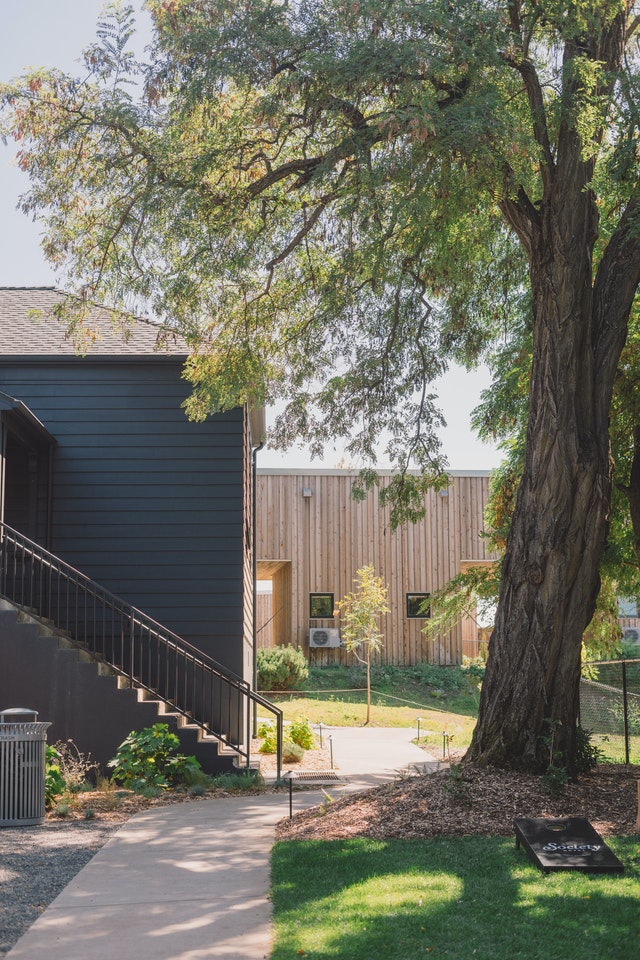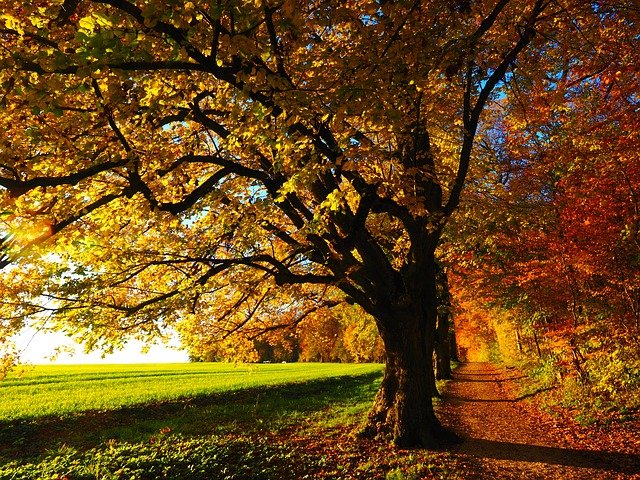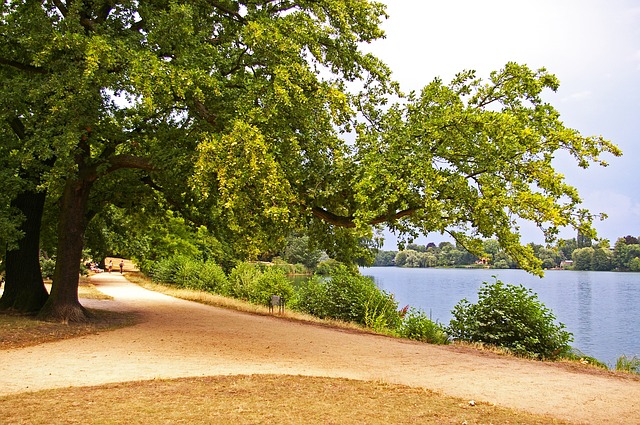New construction may necessitate grade changes to improve drainage on the property. Roots that were formerly in the top few inches of soil may be buried alive under loads of sand and topsoil to ultimately suffocate and die. To preserve existing trees, avoid raising or lowering the soil level under the canopy of the tree.
Building a tree well is one way to maintain air circulation and drainage in the root zone. Tree wells are walled shafts to the original soil grade in landscapes where soil levels have been artificially increased. Digging old-fashioned tree wells dug near a trunk doesn’t work. Dr. Edward Gilman, a professor and tree specialist at the University of Florida, notes that if you’re trying to save a tree with a tree well, you must build it beyond the tree’s dripline, then grade the soil outside the well to keep runoff from flowing into the well. There’s no guarantee that the tree will survive construction, but you improve its chances by leaving undisturbed the trunk and as wide an area as possible around it.
Another common practice that actually harms, rather than helps, is removing part of a tree’s canopy to balance roots killed during construction. The fact is that to survive root disturbance, trees need their leaves to provide nutrients. Removing part of the crown reduces the number of leaves that are processing nutrients. If some limbs ultimately die from root damage, you can ask your arborist to remove them.
Chemical Damage
Trees and shrubs can also sustain damage from herbicides formulated to destroy unwanted plants or stop their growth. Even those herbicides considered safe around people and pets may not be safe your trees. My husband and I learned that lesson the hard way. On a muggy Delaware day with hardly any wind, Bob sprayed herbicide on some persistent weeds near a weeping Japanese maple. A breeze moved the air while he was spraying. We didn’t realize that any herbicide had migrated to the tree until we noticed the decline and death of a small branch near the area where he had been.
Out Of Harm’s Way
Heavy construction equipment isn’t the only thing that can damage a tree trunk. Dinging the trunk with a lawnmower, string trimmer, or any other machine can kill the tree. Even a small bark hit may hurt the part of a tree that carries food and water to and from the leaves and roots and the cell band from which the tree grows. The tree declines, becoming vulnerable to disease-causing organisms. Very young trees with thin bark are particularly at risk from these injuries.
The best way to protect your trees from mechanical harm is to mulch the area beneath them with wood chips, bark nuggets, or shredded bark. A 2 – to 3-inch layer is plenty. Keep the mulch away from the trunk flare. You’ll save mowing time and won’t have to buy new trees.
At Risk From Within
Many tree cultivars have been grafted onto a sturdy rootstock to enhance their growth and vigor. It’s important to remove suckers from these plants. Suckers are the shoots that grow from a tree below the bud union (the swelling where the two plants were joined, usually near the base of the tree). Because of their vigor, suckers can take over a tree or shrub, killing off the less dynamic scion (grafted plant). A pink rosebush can become a red rosebush after the rootstock takes over. Similarly, twisty Harry Lauder’s walking stick (Corylus avellana “Contorta”), can turn into its straight-stemmed species rootstock, C. avellana, if you don’t remove the suckers before they have a chance to grow.
Ozone Pollution
City life has its benefits, but one of its draw-backs is air pollution. You don’t have to live in a city, however, to experience the effects of pollution. Winds, air currents, and moving vehicles carry pollutants across the country and up and down the coasts. Different kinds of trees and shrubs, like individual people, have different tolerances to pollution exposure. Some gets sick fast, while others go on and on, showing few signs of stress. In the landscape, it pays to plant pollution-tolerant plant material if you live in a polluted place or downwind of a polluted environment.
The most prevalent air pollutant hurting trees is ozone. Not all ozone is bad for trees. Beneficial ozone from the earth’s upper atmosphere protects earth from ultraviolet light. But the harmful and excessive ozone in the lower atmosphere comes from everyday things that people do. We drive cars and keep our houses warm in winter, cold in summer. We use more and more energy and demand the manufacture of more sand more goods. Car engines and power plants are among the biggest offenders when it comes to this pollution. Burning coal and gasoline results in the release of gases that combine with oxygen to make ozone. The most harmful ozone develops on warm sunny days, especially in early evening or late afternoon.
Ozone enters a tree through little openings in the leaves. Its presence in leaves reduces the amount of food the tree can make through photosynthesis. Ozone damage can kill or weaken a tree. It becomes vulnerable to pests and debilitating conditions such as stunted development, early leaf loss, and whitening or yellowing of foliage. Leaves can burn at the edges and you may see spotting on the leaf surface. The lists on the following page can help you choose trees to plant if air pollution is a problem where you live.
Pollution-Tolerant Landscape Trees And Shrubs
Hedge maple Acer campestre
European hornbeam Carpinus betulus
Hackberry Celtis occidentalis
White fringe tree Chionanthus virginicus
Hawthorn Crataegus species
Ginkgo Ginkgo biloba
Thornless honey locust Gleditsia triacanthos f.inermis
Longstalk holly Ilex pedunculosa
Golden raintree Koelreuteria paniculata
Crape myrtle Lagerstroemia indica
Magnolia Magnolia species
‘Donald Wyman’ crabapple Malus ‘Donald Wyman’
Amur corktree Phellodendron amurense
White spruce Picea glauca
Japanese black pine Pinus thunbergii
Yoshino flowering cherry Prunus x yedoensis
Douglas fir Pseudotsuga menzisii
English oak Quercus robur
Red oak Quercus rubra
Sumac Rhus species
Chinese scholar tree Sophora japonica
Arborvitae Thuja species
Little-leaf linden Tilia cordata
Landscape Trees Intolerant To Air Pollution
Sugar maple Acer saccharum
Red maple Acer rubrum
Serviceberry Amelanchier species
Catalpa catalpa species
Larch Larix species
Black tupelo Nyssa sylvatica
White pine Pinus strobes
Lombardy poplar Populus nigra ‘ Italica’
Quaking aspen Populus tremuloides
Flowering plum prunus cerasifera
Willow Salix species
American elm Ulmus Americana
When Storms Come Your Way
When a weather disaster occurs, landscape trees can’t evacuate. Rooted to the spot, they rely instead on certain inborn characteristics to survive. If weather-related damage to your trees creates hazardous conditions for you, your pets, or your neighbors, call an arborist immediately. An arborist may be able to save your tree and, will remove it safely from your property.
Snow and ice look magical on trees but they can destroy them. The weight of snow can crush evergreens, breaking them apart. It can weigh down deciduous tree limbs until they also break. Sometimes it weighs so heavily on a treetop that it lifts the root mass right out of the soil. Ice-coated trunks and branches bend low and sometimes snap. When a coastal ice storm hit Maine and New Hampshire one year, every young paper birch along I-95 bowed to the ground. Some broke apart, but many still survive, stooped testaments to the storm. You can help avoid permanent damage by gently brushing snow off branches you can reach. An arborist may need to stake or cable trees vulnerable to folding under the weight of ice. Whether cabled or not, let the ice melt naturally. Prune any damage so the tree will not create a hazard. Well-pruned trees and shrubs stand up better to snow and ice than trees with weak branch crotches or more than one leader (main stem). Typing up boxwood or erect evergreens like red cedar and arborvitae may help prevent injury. Crisscross the entire crown with nylon cord or fishing line, removing it promptly in spring. Protect smaller shrubs with a teepee made from two leaning boards or pieces of plywood.





